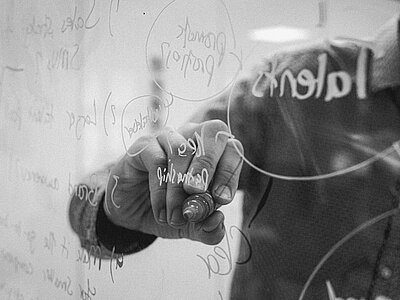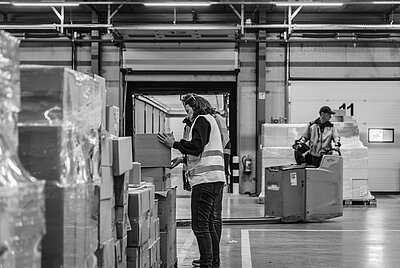Accessibility is vital
Regulations are hugely positive. But that doesn’t mean you have to stop there. Creating environments where everyone feels welcome and seen lets people feel comfortable and at home when they’re experiencing your brand.
Consider the physical accessibility of your stores. Are your physical stores accessible to all? This includes having ramps, wide aisles, and lifts where necessary. Your shelving should be arranged so that all customers, including those in wheelchairs or with other mobility challenges, can reach products easily. And if they can’t, having clear signage on display that makes it clear they simply need to ask for help – and trained staff to assist and offer help freely. Your fitting rooms should be spacious and equipped with features like grab bars and lower hooks.
French supermarket chain, Carrefour, has committed to adapting 50 of its convenience stores and 10 hypermarkets after the opening of a new store in Paris that has a disability reception centre, shopping companion services, trolleys for people with reduced mobility and floor guides to help visually impaired people navigate the store.
But it’s not just physical accessibility that causes problems. Digital accessibility is essential as we move more and more of our services and products online. It’s important to consider how your websites and mobile apps are experienced by people with various disabilities – and it’s covered under the EU Accessibility Act so it’s vital to engage with. This includes providing text alternatives for images, ensuring that your site is navigable via keyboard, and offering screen reader compatibility. Following the Web Content Accessibility Guidelines will help you to create more inclusive digital experiences, and remember, if you have in-store help points or tablets, you also need to consider them in your accessibility plans.
Payment accessibility is also becoming more prominent. Since the pandemic, many retailers have worked hard on digital payment systems and processes, with some moving to become completely cashless – including in their stores. While this enables quick payments for those with digital payment abilities, it also threatens to push out vulnerable and older customers who don’t have access to digital payments or find them difficult to use.
It's important you consider how every customer will experience your payment processes and how you can bring an inclusive approach to these.
Inclusivity is imperative
Accessibility is just half the battle. Your customers need to feel they are represented by your brand in order to feel safe and valued. The Paralympic Games remind us that visibility of people with different needs and abilities is a crucial element of creating positive change.
And you can create this visibility in many different ways. Developing product ranges that are adapted or specifically designed to cater to the needs of people with disabilities is important. This might include adaptive clothing, assistive devices, or products designed for ease of use by people with limited dexterity. Offering a diverse range of products shows your commitment to serving everyone and highlights their importance. For example, Irish fashion retailer Primark has recently released a range of adaptive underwear for people with disabilities.
Don’t forget staff training
Every person you employ will come with their own life experiences – some broad and others not so broad. That’s why inclusivity training for your employees is essential, so that they can understand and meet the needs of your customers with disabilities. This includes learning how to communicate effectively and respectfully with customers who may have speech, hearing, or cognitive impairments. Sensitivity training can help staff become more empathetic and responsive, creating a welcoming and respectful environment across all your retail stores.
Alongside this, your marketing materials should reflect the diversity of your customer base. Featuring individuals with disabilities in your adverts and promotional materials not only promotes inclusivity but also resonates with a broader audience. It’s important for customers to see themselves represented in the brands they support.
Model and disability advocate Jillian Mercado has also broken significant ground in the fashion industry. As a wheelchair user with muscular dystrophy, Mercado has appeared in campaigns for major brands like Diesel and Target and in the pages of leading fashion magazines, challenging norms and setting new standards for representation. And again, Primark has been at the forefront of championing inclusivity in its marketing materials, using models with Downs Syndrome as part of its marketing campaigns.
Be an inclusivity and accessibility champion
Efforts to promote inclusivity and accessibility are constant and consistent. The Paralympics is a reminder of how these efforts are stronger when we all come together. You might choose to champion the cause by partnering with local disability organisations to support and engage with your community. This could involve sponsorships, hosting events, or participating in awareness campaigns. Building strong community ties demonstrates your genuine commitment to inclusivity.
It's also important that you make significant progress with your employees. A diverse workforce enriches your company culture and allows customers to see themselves represented. Striving to create inclusive hiring and employment practices that provide opportunities for people with disabilities and additional needs, will allow you to embolden that commitment.
As we pointed out, inclusivity is an ongoing process. Don’t be afraid to actively seek feedback from customers with disabilities so that you can understand their experiences and find areas for improvement. You could do this through surveys, focus groups, or direct engagement with local charities or organisations. Acting on this feedback proves to your customers that they are valued and can rely on you to have their best interests at heart.
The Paralympic Games show us what’s possible. It’s up to us to continue that work long after it has finished.
If you’d like a retail partner who can support your inclusivity and accessibility goals, speak with our team on +31 (0) 88 494 20 80 or email us at online@worldpack.eu.


